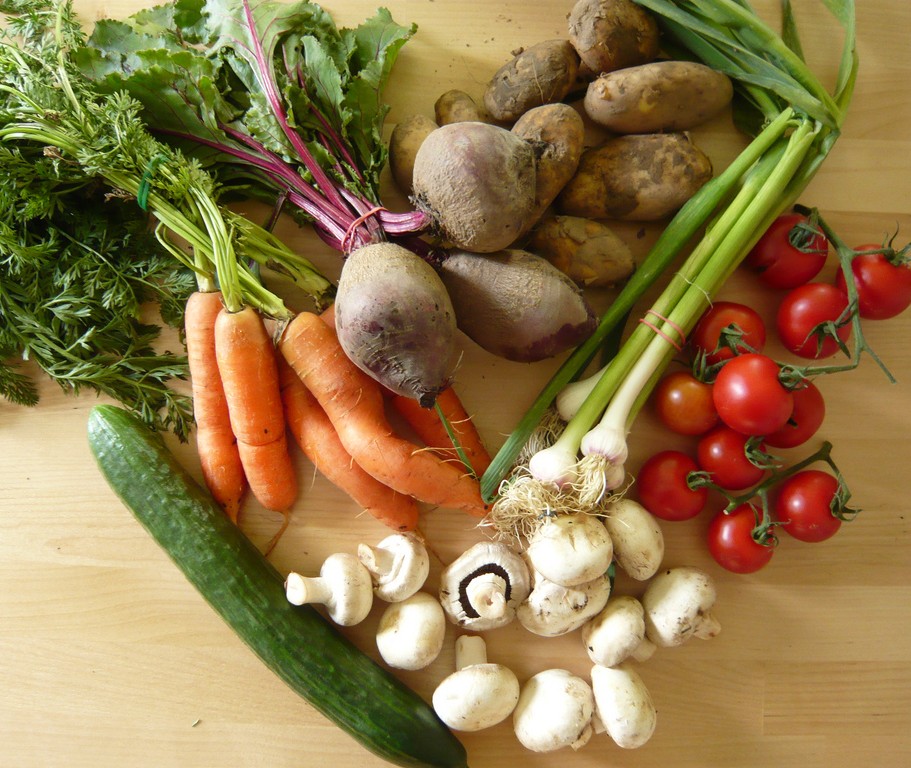 I love to eat. I also want to maintain a healthy weight. So what do I do? After covering my protein and complex carbohydrate needs, I eat high bulk, high nutrient plant foods, including large servings of vegetables and fruits at all meals and most snacks. I get all the nutrients needed for optimal health and maintain a good weight without living on the edge of hunger.
I love to eat. I also want to maintain a healthy weight. So what do I do? After covering my protein and complex carbohydrate needs, I eat high bulk, high nutrient plant foods, including large servings of vegetables and fruits at all meals and most snacks. I get all the nutrients needed for optimal health and maintain a good weight without living on the edge of hunger.
Although most of us enjoy the sweet flavors of fruits, not everyone loves vegetables. I learned the joys of fresh picked green beans and tomatoes ripe from the sun at my grandmother’s table. Besides good taste, simply prepared fruits and vegetables add visual and textural pleasure to meals and snacks. Your body will thrive on the rich reds of tomatoes, the orange pigments in sweet potatoes, and the deep greens of leaves.
Vegetable preparation can take a chunk of time. It’s tempting to go heavy on protein and carbohydrates and skip the vegetables, but we need plant foods to reach our health and fitness potential. This page explains the healthful qualities of plant foods and gives practical information to help you improve your diet without spending your whole life in the kitchen.
Health Benefits of Plant Foods
Plant foods provide a wide assortment of vitamins, minerals, and other nutrients such as flavonoids, isoflavones, lycopenes, and lignans. We’re just beginning to understand how our bodies use these complex micro-nutrients and many, if not most, of them haven’t been identified or classified, much less understood. We do know that plants provide important antioxidants and help in healing processes. Plant foods decrease the risk of heart disease, stroke, and high blood pressure and guard against a number of eye diseases and intestinal ailments. Supplements do not substitute for the nutrients in whole food, although supplements can protect us from some deficiency diseases.
How Much Is Enough?
The recommended 5 servings of fruits and vegetables a day is an absolute minimum, but most Americans eat just 2-4 servings a day. The number of daily servings is inflated by including white potatoes that are digested more like processed grains, so leave potatoes out of your calculation. When you’re trying to become healthy and fit, it’s wise to aim for 8-10 servings a day. That sounds like a lot, but servings are small—½ cup of cooked or finely chopped or grated raw vegetables, 1 cup of raw chopped leafy greens, 1 small fruit, ½ cup chopped fruit, ¼ cup dried fruit, or 6 ounces of fruit or vegetable juice. Here’s a hypothetical day that provides 10 servings.
- · Breakfast of ½ grapefruit and oatmeal with raisins—2 servings
- · Lunch with 1 ½ cup of vegetable soup, 8 baby carrots, and a piece of fresh fruit—4 servings
- · Snack of low fat cottage cheese with ½ cup blueberries—1 serving
- · Dinner with 2 cups green salad and ½ cup cooked kale or other greens—3 servings
That wasn’t hard!
Which Plants Do We Choose?
The variety of vegetables and fruits is astounding, so it’s easy to eat something every day from each category on the following list. I’ve only included a few of the many nutrients that are available in each type of food. There’s overlap between categories and no need to be rigid in your selections, but it boils down to this: eat some plant foods raw, choose a wide variety of colors, choose something high in vitamin C, and eat a serving of dried beans or peas most days.
A. 1-2 servings of raw vegetables and 1 of raw fruit (high in Vitamin C and folate)
B. 1 serving of dark green vegetables like broccoli or kale (high in calcium, iron, and folate)
C. 1 serving of yellow or orange such as carrots (high in betacarotene and Vitamin A)
D. 1 red or purple like tomatoes, berries, or red grapes (high in C, lycopenes, and flavonoids)
E. 1 serving of high vitamin C as in citrus or berries or tomatoes
F. 1 serving of legumes (dried beans or peas high in protein, fiber, and folate)
How does my 10 serving per day list work with this variety list? We have grapefruit and other fresh fruits, plus a green salad to cover A or raw foods. We have cooked greens at dinner for B. We have orange colored carrots for lunch for C, berries with cottage cheese cover D and E, and dried beans in the soup cover F. It’s not difficult to cover all the categories if you go for variety and color.
Fresh fruits and vegetables are usually most nutritious and taste the best. Frozen vegetables are next best and can be more nutritious than produce that’s been sitting around the store too long. Frozen vegetables are convenient time-savers, and you can buy them ahead and keep a supply in your freezer. Most canned vegetables and fruits are less healthy, because nutrients are lost in the high-heat canning process or they contain sugar or excess salt. On the other hand, canned dried beans are excellent because they’re precooked, easy to use, and lose very few nutrients in the canning process, but buy ones without preservatives. Eden Organic canned beans have no added salt and have BPA-free liners in the cans. Buy organic produce if you can afford it. Agribusinesses use many pesticides because consumers want perfect looking produce and will reject a spinach leaf or red pepper that has an insect bite.
Grocery stores offer a huge selection of fresh fruits from all over the world. I take advantage of what’s in season. In the winter, I keep a good supply of oranges, grapefruit, and apples in my cool cellar. Year round, I splurge on luscious fruits to eat with cottage cheese for a high protein afternoon snack.
Choose whole unprocessed fruits or vegetables when you can. An apple contains healthful fiber lost in juicing and vitamin C and folic acid lost in cooking, and a raw apple is the same number of calories as 6-8 ounces of apple juice and lots more filling. The food processing industry is masterful at turning something healthy into junk food, as in the case of fruit rollups or fruit juice spritzers, so buy foods that haven’t been processed and read labels. There are exceptions to the rule that less cooking or processing means higher nutrients. Cooked or juiced carrots have more bioavailable betacarotenes than whole raw ones. Cooked tomatoes, especially if they are prepared with a little oil, have more bioavailable lycopenes than raw tomatoes. Anyone for a marinara sauce of olive oil, garlic, tomatoes, and basil?
Practical Ways to Add Vegetables To Your Diet
I’ve been a vegetarian for 30 years, so I’ve developed many strategies for simplifying vegetable preparation. Invest in good tools by purchasing quality knives with hard steel for chopping and slicing, an effective system for sharpening your knives, good vegetable peelers, and large cutting boards. I also use a Cuisinart for slicing or chopping.
- Soups: Soups are my favorite way to have a high vegetable lunch in all but the hottest weather. Every weekend, I cook a big pot of vegetable soup. At home I heat a large bowl for lunch in the microwave, or I carry a packed lunch that includes hot soup in my 2 cup wide-mouth thermos. Check out my favorite soup recipes. Most of my soups contain a healthy balance of grains and proteins in the form of legumes along with the vegetables. You’ll also find great vegetable soups in many cookbooks. Sometimes I double or triple recipes and freeze soups in quart-size containers.
- Baked winter squash and sweet potatoes: These can be cooked ahead in the microwave or oven and warmed up when you want to eat them. They’re filling, high in nutrients, and low on the glycemic index scale.
- Green salads: Take advantage of salad bars or prepared salad greens packaged or in bulk. When making salad for dinner, make enough to have a serving or two for lunch the next day. I find it easier to make salad when I have good salad dressing on hand. See my recipe for balsamic vinegar, garlic, and olive oil dressing made in large quantities in the blender for a fast no-chopping preparation. It tastes better and is less expensive than anything you can buy, and you can make enough to last for a few weeks in a few minutes. Also look for my favorite green salad ingredients.
- Marinated vegetables: My Italian mother-in-law taught me to steam vegetables like broccoli, green beans, or cauliflower, plunge them in cold water to preserve color and texture, mix them with a dressing of olive oil, wine vinegar, fresh garlic, salt, and pepper, and eat them chilled or at room temperature. They keep refrigerated for a few days for a quick addition to lunch or dinner. I make marinated vegetables when the weather is too hot for soup, and I always make enough to last for a few lunches.
- Vegetables for steaming, microwaving, or stir-frying: Larger grocery stores have packaged ready-to-eat chopped vegetables like broccoli. Simply rinse and cook. Keep frozen vegetables in your freezer for fast soups and other vegetable dishes. I freeze vegetables from my garden in the summer; when I want to add greens to a soup, I drop in a package of frozen kale. You can do the same with frozen vegetables you buy. Cruciferous vegetables (cabbage family such as broccoli, rapini, or mustard greens) are especially nutritious.
Continue improving your diet, one step at a time, one day at a time, one month at a time. If you eat few vegetables or fruits, try adding 1 or 2 servings a day for a few weeks and then add a little more. Add a little each week and in a few months, your diet will be transformed. If you’re already eating well, make your diet terrific by adding more variety. Your body will reward you for your efforts.
